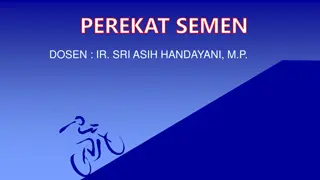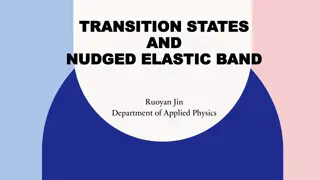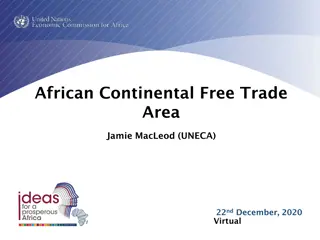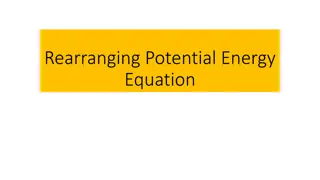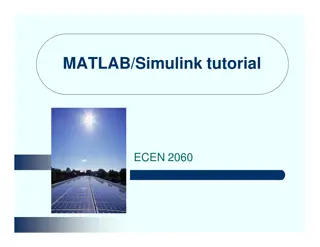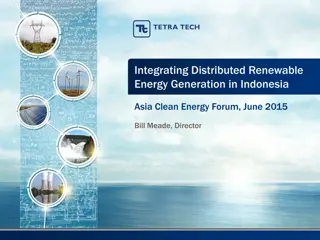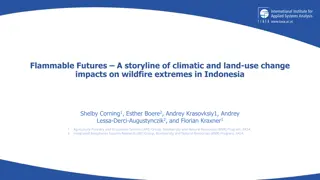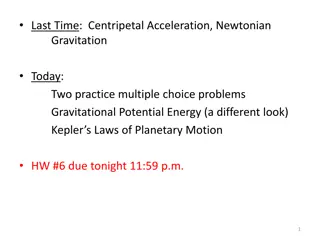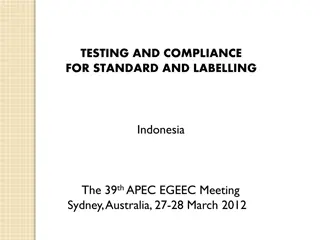Energy Transition and NRE Potential in Indonesia's Path to NZE 2060
Indonesia is focused on transitioning to Net Zero Emissions by 2060, with a significant emphasis on New Renewable Energy (NRE) sources. The country has made strides in increasing NRE utilization, with promising potential in hydro, solar, wind, geothermal, and ocean energy. Additionally, Indonesia is committed to reducing greenhouse gas emissions, as outlined in the G20 agreements and enhanced NDC targets. The Bali Compact and Bali Roadmap serve as guiding frameworks for achieving energy market stability, accessibility, and sustainability through collective efforts. The energy sector in Indonesia has shown notable progress in reducing GHG emissions, aligning with international commitments towards a sustainable future.
Download Presentation

Please find below an Image/Link to download the presentation.
The content on the website is provided AS IS for your information and personal use only. It may not be sold, licensed, or shared on other websites without obtaining consent from the author. Download presentation by click this link. If you encounter any issues during the download, it is possible that the publisher has removed the file from their server.
E N D
Presentation Transcript
DIRECTORATE GENERAL OF NEW, RENEWABLE ENERGY AND ENERGY CONSERVATION MINISTRY OF ENERGY AND MINERAL RESOURCES INDONESIA ENERGY TRANSITION TOWARDS NZE 2060 Dadan Kusdiana Director General of New, Renewable Energy and Energy Conservation at Japan RE-Invest Indonesia Forum 2023 Tokyo, March 3rd, 2023 www.esdm.go.id kesdm
CONDITION AND POTENTIAL OF NRE TO SUPPORT ENERGY TRANSITION National Primary Energy Demand | MBOE NRE in The National Energy Mix 500 23% 24% 1734*) 22% 19.5% 659.3 1558 400 20% 17.9% 1485 1465 522.9 1438 214 18% NRE utilization in 2022 increased by 18% (213.8 MBOE), 2021 consumption. 1335 15.7% 143 448.6 14.5% 126 181 162 16% 13.4 89 300 366.4 12.2% 665 14% 11.6% 581 12.3%*) 483 408 559 554 12% from 12.2% 200 10% 11.2% 285 288 286 289 250 8% 9.2% 251 214 8.6% 181 6% 100 162 570 567 553 545 496 471 4% 143 126 2% 0 0% 2017 2018 2019 2020 2021 2022 2018 2019 2020 2021 2022 2023 2024 2025 Oil Gas Coal NRE Total Realization (MBOE) Target (MBOE) Realization (%) Target (%) *) Temporary Data Electricity Consumption | kWh/capita National NRE Potential and Utilization Hydro: all over Indonesia s areas, particularly in North Kalimantan, NAD, North Sumatra and Papua. POTENTIAL (GW) UTILIZATION (MW) ENERGY Solar: all over Indonesia s areas, particularly in East Nusa Tenggara, West Kalimantan and Riau which has higher radiation. 1173 National consumption amounted kWh/capita, lower than the average electricity consumption in ASEAN of 3,600 kWh/capita. electricity in 2022 to 1,173 SOLAR 3,295 272 1123 HYDRO 95 6,689 1089 1084 1064 BIOENERGY 57 3,087 Wind (>6 m/s): particularly located in East Nusa Tenggara, South Kalimantan, West Java, NAD and Papua. 1021 WIND 155 154 956 GEO THERMAL 24 2,355 Ocean: all over Indonesia s areas, particularly in Maluku, East Nusa Tenggara, West Nusa Tenggara and Bali. 910 OCEAN 60 0 TOTAL 3,686 12,557 Geothermal: in ring of fire areas, including Sumatra, Java, Bali, Nusa Tenggara, Sulawesi, and Maluku. Note: *) December 2022 Nuclear pot.: Uranium 89,483 tons - Thorium 143,234 tons 2015 2016 2017 2018 2019 2020 2021 2022 DG NREEC @2023 2
INDONESIA COMMITMENT IN GHG EMISSION REDUCTION The G20 leaders reiterated the commitment to achieve global net zero greenhouse gas emissions/carbon neutrality by or around mid-century, while taking into account the latest scientific developments and different national circumstances. Enhanced NDC 2010 GHG Emission (Million Ton CO2e) GHG Emission by 2030 Reduction No Sector BaU CM1 CM2 CM1 CM2 The commitment to achieve the targets of SDG7 was also reaffirmed and the gaps in energy access will be closed to eradicate energy poverty. G20 Presidency 1. Energy 453.2 1,669 1,311 1,223 358 446 Recover Together, Recover Stronger 2. Waste 88 296 256 253 40 45.3 Bali Compact and Bali Roadmap are regarded as the guides to realize energy market stability, transparency, and affordability. 3. IPPU 36 70 63 61 7 9 4. Agriculture 111 120 110 108 10 12 5. FOLU 647 714 217 -15 500 729 TOTAL 1,334 2,869 1,953 1,632 915 1,240 Bali COMPACT Nine accelerating clean, sustainable, just, affordable, and transitions to ensure smooth and effective transitions in accordance with national circumstances and priorities. Bali Roadmap Outlining concrete actions to address energy transition effort among members, by realizing three priorities (energy accessibility, technology scale-up, and financing) through active involvement and collaboration of G20 countries. Note: CM: Counter Measure; CM1: self effort; CM2: international assistance; IPPU: industrial processes and production use voluntary principles for Unit: Million Tons CO2e Through Indonesia raised its carbon emission reduction target, the energy increased from 314 million tonnes of CO2e to 358 million tonnes of CO2e Enhanced NDC inclusive energy Target 116 Realization sector has 91.5 91 70 64.4 54.8 Every year, the emission reduction is increasing above the target. By 2022, the energy sector was able to reduce GHG emissions by 91.5 million tonnes of CO2e. COP 27, NOVEMBER 20, 2022 Indonesia continues to take concrete steps, including GHG emission reduction by increasing the target to 31.89% with its own ability, and 43.20% with international support. 40.6 29 2017 2018 2019 2020 2021 2022 2023 DG NREEC @2023 3
STRATEGIES TO ACHIEVE NZE 2060 IN ENERGY SECTOR Roadmap for NZE 2060 or sooner Net Zero Emission 2060 | Million Ton CO2e Supply: NRE Development based on RUPTL 2021-2030, cofiring on CFPP Supply: Green begin to substitute natural gas, NRE dominate the energy mix Supply: Green Hydrogen utilization begin in 2031 for transportation sector, BESS in 2034 Hydrogen utilization Demand: Induction stove, city gas expansion, B35 mandatory, EV, energy mandatory & MEPS. Demand: Induction stove, gas network, B40 mandatory, EV, & hydrogen for industry. Demand: Induction stove, gas network, B40 mandatory, management, & hydrogen for transportation sector EV, energy management 2021-2025 2031-2035 2036-2040 2041-2050 2051-2060 93% emission reduction from BaU will be realized by optimizing supply side by using NRE and demand side by energy efficiency. 2026-2030 Supply: NRE Development based on RUPTL 2021-2030, pump storage starts by 2025 Supply: Nuclear PP starting 2039, massive Solar PV development, along with onshore and offshore wind PP. Supply: All electricity are generated by NRE PP. Remaining emission level: 129 million tons CO2. NZE Strategies GHG Electrification (EV, induction stove, electrifying agriculture, etc) CFPP Moratorium & early retirement of existing CFPPs 3 5 CCS/CCUS 1 Demand: Induction stove, gas network, B40 mandatory, EV, and CCS for cement and steel industry Demand: Induction network, B40 mandatory, DME, EV. Demand: Induction stove, gas network, EV, and CCS for industry stove, gas Energy management mandatory and MEPS 2 4 New energy sources (hydrogen and ammonia) 6 NRE Development (offgrid, ongrid, biofuel) DG NREEC @2023 4
OPTIMIZING NRE: SUPER GRID DEVELOPMENT, REBID, & MINERAL DOWNSTREAMING Super Grid and RE Sharing Resources Indonesia's Mineral Potential to Support the Energy Transition Power Generators (Solar, Wind, & Nuclear) Ni Co REE U Rare earth elements Uranium Nickel Cobalt Transmission & Distribution Al Mn Cr Zr CU Alumunium Manganese Chromium Zirconium Copper Energy Storage (Machinery and EV Battery; Hydrogen) Smelter Development Plan (2022: 5 Completed and 2 Construction) In order to optimize Indonesia s unique circumstances as an archipelagic country in which RE resources are widespread all over the country, a modern and integrated super grid is required, to establish resilient and robust transmission infrastructure in Indonesia. Objectives: Ramping up renewable energy development. Maintaining the transmission stability and security. Addressing mismatch between renewable energy resources and the location of high electricity demand area. Providing and expanding energy access. DG NREEC @2023 5
NREEC OPPORTUNITIES FOR GREEN INVESTMENT Utilizing NRE for Industry RENEWABLE ENERGY BASED INDUSTRIAL DEVELOPMENT (REBID) REBID is carried out through a demandcreation approach to integrate regional and industrial development, attract investment, and increase regional economic development Rooftop Solar PV Regulated in the MEMR Decree No. 26/2021, currently under revision to further accelerate the implementation. As of December 2022, 80.45 MWp of Rooftop Solar PV has been installed by 6,522 customers. Reduce emissions and monthly electricity bills. Industrial Area Large Hydropower & Direct Use Geothermal Project Hydropower projects to be developed include 9,000 MW Kayan Hydropower that will be develop in stages and Mentarang Hydro 1,375 MW. Other large scale hydro potential project includes Mamberamo hydropower in Papua. Geothermal has a high thermal efficiency (80-90%) Many resources of shallow geothermal for potential direct use. Generally used for the agricultural sector (such as tea, coffee, palm sugar) and tourism (hot springs) Industrial Growth Regions NRE Sources Special Economic Area Industrial Development Area Green Industry Development in Tanah Kuning Industrial Area: In accordance with the Directive of the President of the Republic of Indonesia on October 13, 2021 to develop 20 thousand hectares of Green Industrial Park in North Kalimantan Will be the location of industrial development Renewable fuels, green hydrogen New energy battery Ternary Cathode Green Aluminium Utilization of Waste and Biomass Utilization of waste/biomass as boiler fuel has been carried out in industries such as PT. Sari Husada, Holcim Cement Factory, Pulp and Paper Industry, etc The use of waste/biomass in small and medium industries such as tile and ceramics industries is common in society Biomass is also used in the cofiring program, with existing CFPPs DG NREEC @2023 6
ENERGY CONSERVATION PROGRAM Standardization and Labeling Application Regulation for Energy Efficiency in buildings through SNI:6390:2020 Energy Conservation of air conditioning systems in buildings. It provides recommendations for Coefficient of Performance (COP) Value for electric air conditioning (chillers). Standardization and Label for Appliances Implementation of Energy Saving Technology (inverter technology, electric motor, boiler, etc.) Roadmap for mandatory home appliances MEPS 2021-2030 (GWh) Lamps (Tech Neutral) 1,311,177 1,212,546 Blender Water Pump Iron The implementation of MEPS can save the energy up to 8% (98,632 GWh) or 62 MBOE and will reduce GHG 83.8 Million Tons of CO2 Mandatory of Energy Management Implementation (ISO 50001) Washing Machine Water Dispenser AC Electric Fan Energy Efficiency Investment, energy conservation service business development TV Refrigerator Rice Cooker BAU 2021-2030 (GWh) MEPS 2021-2030 (GWh) Awareness & Awards. Potential Minimum Energy Performance Standards for the industrial sector: Electric vehicles, chillers, transformers and boilers.
STRENGTHENING NREEC POLICIES TO ACCELERATE ENERGY TRANSITION INVESTMENT PRES. REGULATION NUMBER 112/2022 PRES. REGULATION NUMBER 11/2023 on Additional Concurrent Government Affairs in the Energy and Mineral Resources Sector for the NRE Subfield. RE development is carried out based on the RUPTL document, with consideration of the NRE mix target, supply-demand, and economic value. To support the utilization of EBT in the primary energy mix and the achievement of global emission reduction, it is necessary to optimize the authority of coordination and synergy between the Government and Regional Governments. Highest Benchmark Price (HPT) for 2-stage staging without escalation with location factors applies to stage 1, for each type of renewables: Jenis Stage 1 (cUSD/kWh) Stage 2 (cUSD/kWh) Additional Concurrent Government Affairs for Local Governments: Geothermal 7.65 9.76 x F 6.5 8.30 management of Biomass and/or Biogas supply within the province. a Large Hydro 6.74 11.23 x n x F 4.21 7.02 management of the utilization of Biomass and/or Biogas as fuel in the provincial area Excess Power Hydro 5.80 x 0.7 b Solar 6.95 11.47 x n x F 4.17 6.88 management of Various New Renewable Energy sourced from solar, wind, waterfall, as well as the movement and temperature difference of the ocean layer, within the province. Wind 9.54 11.22 x n x F 5.73 6.73 c Biogas 7.44 10.18 x n x F 4.46 6.11 x n Biomass 9.29 11.55 x n x F 7.43 9.24 x n Energy Conservation management for activities whose business license is issued by the provincial region d n: Technical factor (0.7 1.0) F: Location factor (1 1.5) Deal Price (requires MEMR approval): Peaker Hydro; Biofuel PP; Ocean PP implementation of Energy Conservation in facilities and infrastructure managed by the regional apparatus that organizes government affairs in the field of energy and mineral resources. e Pres. Regulation 112/2022 also mandates the Government c.q. The MEMR to prepare a roadmap to accelerate the retirement of the CFPP's operational life and limit the development of new CFPPs, except for those CFPPs that have been listed in the RUPTL or which are integrated with industry; committed to reduce GHG more than 35% in 10 years since CFPP started operation through technology dev., carbon offset, and/or increasing RE mix; and operated until 2050. guidance and supervision of the implementation of Energy Conservation carried out by stakeholders at the provincial level. f NRE LAW DRAFT As a comprehensive regulation to create a sustainable and fair climate for NRE development LICENSE & PERMIT RESEARCH & DEVELOPMENT ENERGY TRANSITION ROADMAP NRE RESOURCES NUCLEAR PRICE INCENTIVE INSITUTIONAL AUTHORITY NRE FUND GUIDANCE AND SUPERVISION NRE PROVISION OBLIGATION ENERGY CONSERVATION PUBLIC LOCAL CONTENT PARTICIPATION
THANK YOU www.esdm.go.id Adress Jl. Pegangsaan Timur No.1, Cikini, Menteng Jakarta Kementerian Energi dan Sumber Daya Mineral @kesdm KementerianESDM @KementerianESDM DG NREEC @2023 9




